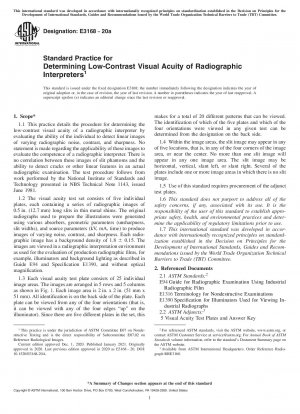ASTM E3168-20a
Standard Practice for Determining Low-Contrast Visual Acuity of Radiographic Interpreters
- Standard No.
- ASTM E3168-20a
- Release Date
- 2020
- Published By
- American Society for Testing and Materials (ASTM)
- Latest
- ASTM E3168-20a
- Scope
- 1.1 This practice details the procedure for determining the low-contrast visual acuity of a radiographic interpreter by evaluating the ability of the individual to detect linear images of varying radiographic noise, contrast, and sharpness. No statement is made regarding the applicability of these images to evaluate the competence of a radiographic interpreter. There is no correlation between these images of slit phantoms and the ability to detect cracks or other linear features in an actual radiographic examination. The test procedure follows from work performed by the National Institute of Standards and Technology presented in NBS Technical Note 1143, issued June 1981. 1.2 The visual acuity test set consists of five individual plates, each containing a series of radiographic images of 0.5 in. (12.7 mm) long slits in thin metal shims. The original radiographs used to prepare the illustrations were generated using various absorbers, geometric parameters (unsharpness, slit widths), and source parameters (kV, mA, time) to produce images of varying noise, contrast, and sharpness. Each radiographic image has a background density of 1.8 6 0.15. The images are viewed in a radiographic interpretation environment as used for the evaluation of production radiographic films, for example, illuminators and background lighting as described in Guide E94 and Specification E1390, and without optical magnification. 1.3 Each visual acuity test plate consists of 25 individual image areas. The images are arranged in 5 rows and 5 columns as shown in Fig. 1. Each image area is 2 in. x 2 in. (51 mm x 51 mm). All identification is on the back side of the plate. Each plate can be viewed from any of the four orientations (that is, it can be viewed with any of the four edges “up” on the illuminator). Since there are five different plates in the set, this makes for a total of 20 different patterns that can be viewed. The identification of which of the five plates and which of the four orientations were viewed in any given test can be determined from the designation on the back side. 1.4 Within the image areas, the slit image may appear in any of five locations, that is, in any of the four corners of the image area, or near the center. No more than one slit image will appear in any one image area. The slit image may be horizontal, vertical, slant left, or slant right. Several of the plates include one or more image areas in which there is no slit image. 1.5 Use of this standard requires procurement of the adjunct test plates. 1.6 This standard does not purport to address all of the safety concerns, if any, associated with its use. It is the responsibility of the user of this standard to establish appropriate safety, health, and environmental practices and determine the applicability of regulatory limitations prior to use. 1.7 This international standard was developed in accordance with internationally recognized principles on standardization established in the Decision on Principles for the Development of International Standards, Guides and Recommendations issued by the World Trade Organization Technical Barriers to Trade (TBT) Committee.
ASTM E3168-20a Referenced Document
- ASTM E1316 Standard Terminology for Nondestructive Examinations*, 2024-02-01 Update
- ASTM E1390 Standard Guide for Illuminators Used for Viewing Industrial Radiographs
- ASTM E94 Standard Guide for Radiographic Examination*, 2024-04-21 Update
- ISO 9712 Non-destructive testing — Qualification and certification of NDT personnel*, 2021-12-21 Update
ASTM E3168-20a history
- 2020 ASTM E3168-20a Standard Practice for Determining Low-Contrast Visual Acuity of Radiographic Interpreters
- 2020 ASTM E3168-20 Standard Practice for Determining Low-Contrast Visual Acuity of Radiographic Interpreters
